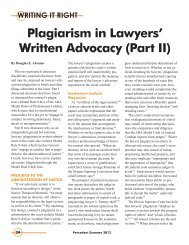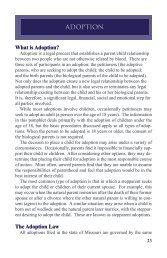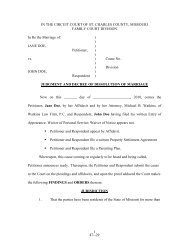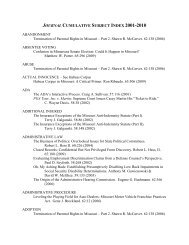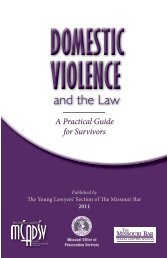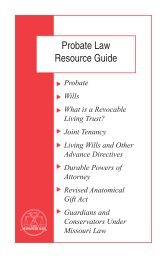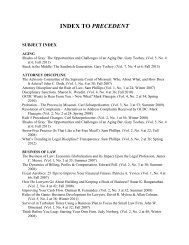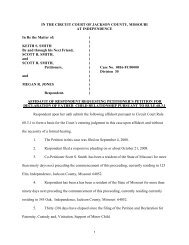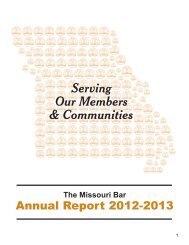Victim Confidentiality Laws Promote Safety and ... - the Missouri Bar
Victim Confidentiality Laws Promote Safety and ... - the Missouri Bar
Victim Confidentiality Laws Promote Safety and ... - the Missouri Bar
Create successful ePaper yourself
Turn your PDF publications into a flip-book with our unique Google optimized e-Paper software.
<strong>Victim</strong> <strong>Confidentiality</strong><br />
<strong>Promote</strong> <strong>Safety</strong> <strong>and</strong> Di<br />
BY KELLIE WINGATE CAMPBELL 1<br />
Kellie Wingate Campbell<br />
76 / Journal of <strong>the</strong> MISSOURI BAR<br />
Introduction<br />
<strong>Victim</strong> confidentiality is a subject<br />
surfacing with increasing frequency at<br />
both <strong>the</strong> national 2 <strong>and</strong> international 3<br />
levels as victims become more vocal<br />
in <strong>the</strong>ir efforts to keep <strong>the</strong>ir personal<br />
information private, citing concerns<br />
for <strong>the</strong>ir physical safety as well as<br />
<strong>the</strong>ir privacy. One of <strong>the</strong> most recent<br />
examples of this may be found in<br />
<strong>the</strong> highly-publicized trial of Jerry<br />
S<strong>and</strong>usky, where several victims asked<br />
that <strong>the</strong> trial court allow <strong>the</strong>m to be<br />
identified by numbers or pseudonyms<br />
ra<strong>the</strong>r than require <strong>the</strong>m to state<br />
<strong>the</strong>ir names at a public trial that 250<br />
reporters had registered to attend. 4 The<br />
trial court’s response reflected what<br />
many perceive to be <strong>the</strong> status quo:<br />
No victim of crime, after<br />
all, is spared <strong>the</strong> trauma of<br />
crime’s effects. . . . Arguably<br />
any victim of crime would<br />
prefer not to appear in court,<br />
not to be subjected to crossexamination,<br />
not to have his or<br />
her credibility evaluated by a<br />
jury – not to put his name <strong>and</strong><br />
reputation at stake. But we ask<br />
citizens to do that every day in<br />
courts across <strong>the</strong> nation. 5<br />
Deviating from <strong>the</strong> recent rulings<br />
of o<strong>the</strong>r courts facing similar requests,<br />
<strong>the</strong> S<strong>and</strong>usky court denied <strong>the</strong> victims’<br />
motion, citing lack of authority in<br />
Pennsylvania law. 6<br />
The concept of applying a greater<br />
level of confidentiality or privacy to<br />
victims of crime may represent a shift<br />
in thinking, but it need not conflict<br />
with defendants’ rights or fundamental<br />
rules of disclosure. Certainly, <strong>the</strong>re<br />
are consequences for prosecutors who<br />
violate Rule 25.03, Brady v. Maryl<strong>and</strong> 7<br />
<strong>and</strong> <strong>the</strong> Confrontation Clause 8 by<br />
withholding information in discovery,<br />
<strong>and</strong> this alone might suggest erring<br />
on <strong>the</strong> side of over-disclosure ra<strong>the</strong>r<br />
than under-disclosure; however, it is<br />
possible (<strong>and</strong> necessary) to strike an<br />
appropriate balance between defendants’<br />
<strong>and</strong> victims’ rights. Adherence to <strong>the</strong><br />
law, including victims’ rights laws, is<br />
not only a key aspect of professional<br />
responsibility, it also reinforces <strong>the</strong><br />
integrity of a judicial system that has<br />
been criticized for “revictimizing” those<br />
who come forward in search of justice<br />
for horrendous crimes. 9 In <strong>Missouri</strong>,<br />
<strong>the</strong>re is growing statutory authority<br />
in support of victim confidentiality in<br />
certain circumstances, as well as support<br />
in case law. This article explores <strong>the</strong><br />
legal authority in place that provides<br />
for victim confidentiality with regard to<br />
non-disclosure of identity, location <strong>and</strong><br />
certain confidential communications,<br />
<strong>and</strong> encourages <strong>the</strong> active application of<br />
those laws.<br />
Redaction from <strong>the</strong> Public Record:<br />
§ 566.226<br />
Rule 25.03(A)(1) states that <strong>the</strong><br />
state shall disclose names, addresses<br />
<strong>and</strong> statements of victims <strong>and</strong> o<strong>the</strong>r<br />
witnesses to <strong>the</strong> defendant. The<br />
disclosure of names <strong>and</strong> addresses<br />
usually appears on public charging<br />
documents <strong>and</strong> subsequent filings.
<strong>Laws</strong><br />
gnity<br />
This practice is gradually changing<br />
with regard to victims of sexual <strong>and</strong><br />
domestic assault <strong>and</strong> stalking, because<br />
<strong>the</strong>ir identities <strong>and</strong> addresses are now<br />
protected from disclosure in public<br />
documents by § 566.226.1, which<br />
states:<br />
After August 28, 2007, any<br />
information contained in any<br />
court record, whe<strong>the</strong>r written<br />
or published on <strong>the</strong> internet,<br />
that could be used to identify<br />
or locate any victim of sexual<br />
assault, domestic assault,<br />
stalking, or forcible rape shall<br />
be closed <strong>and</strong> redacted from<br />
such record prior to disclosure<br />
to <strong>the</strong> public. Identifying<br />
information shall include <strong>the</strong><br />
name, home or temporary<br />
address, telephone number,<br />
Social Security number or<br />
physical characteristics. 10<br />
The language of § 566.226 requiring<br />
redaction from <strong>the</strong> court record appears<br />
by implication to place responsibility<br />
with <strong>the</strong> court clerk for identification<br />
of protected information. 11 In spite<br />
of occasional, testy debate on <strong>the</strong><br />
matter, <strong>the</strong> practical responsibility for<br />
removal of protected information falls<br />
on <strong>the</strong> attorney filing any documents<br />
containing information that could<br />
identify victims of <strong>the</strong> classes of crimes<br />
identified in § 566.226. The tendency<br />
to rely on <strong>the</strong> circuit clerk to take up<br />
<strong>the</strong> task of redaction overlooks <strong>the</strong> fact<br />
that <strong>the</strong> circuit clerk does not have<br />
as much information as <strong>the</strong> attorney<br />
h<strong>and</strong>ling <strong>the</strong> case <strong>and</strong> is, <strong>the</strong>refore, not<br />
in <strong>the</strong> best position to determine names<br />
<strong>and</strong> addresses subject to redaction.<br />
More importantly, documents filed<br />
with <strong>the</strong> court electronically now<br />
reach <strong>the</strong> public with greater speed<br />
<strong>and</strong> an increased likelihood of being<br />
viewed before accidental disclosures are<br />
identified <strong>and</strong> corrected.<br />
Several categories of attorneys should<br />
consider carefully whe<strong>the</strong>r information<br />
included in <strong>the</strong>ir filings is subject to<br />
redaction under this statute, <strong>the</strong> most<br />
obvious of which are prosecutors <strong>and</strong><br />
criminal defense attorneys. This list goes<br />
on, however, to include counsel who are<br />
called upon to file motions to quash on<br />
behalf of <strong>the</strong>ir clients, such as hospitals,<br />
medical clinics, counselors, <strong>the</strong>rapists,<br />
mental health centers, social service<br />
agencies, churches, religious advisors<br />
<strong>and</strong> a host of o<strong>the</strong>r agencies outside <strong>the</strong><br />
judicial system that come into contact<br />
with victims of crime. <strong>Confidentiality</strong><br />
laws also provide instruction to<br />
counsel filing motions on behalf of <strong>the</strong><br />
media, which often opposes proposed<br />
confidentiality legislation. 12 Although<br />
<strong>the</strong> statute falls within <strong>the</strong> criminal<br />
code, <strong>the</strong> safety <strong>and</strong> privacy issues<br />
March-April 2013 / 77
underlying <strong>the</strong> statute should be<br />
considered in civil cases as well.<br />
It is worth pointing out that<br />
§ 566.226 does not specifically require<br />
that <strong>the</strong> “victim” be defined only as<br />
<strong>the</strong> named victim in <strong>the</strong> case at h<strong>and</strong>,<br />
allowing for broad application of <strong>the</strong><br />
protection of anonymity in <strong>the</strong> public<br />
record. If <strong>the</strong> mo<strong>the</strong>r of <strong>the</strong> victim<br />
in a child molestation case discloses<br />
that she was physically abused by <strong>the</strong><br />
offender at some time in <strong>the</strong> past, it<br />
can be argued that she is a victim of<br />
domestic assault <strong>and</strong> is, <strong>the</strong>refore,<br />
entitled to protection under <strong>the</strong><br />
statute, even though she may have<br />
never reported <strong>the</strong> abuse. Regardless<br />
of her history, <strong>the</strong> mo<strong>the</strong>r of <strong>the</strong><br />
victim should not be identified by<br />
name in public documents, because<br />
to name <strong>the</strong> mo<strong>the</strong>r is to disclose <strong>the</strong><br />
identity of <strong>the</strong> victim, a violation of<br />
§ 566.226. Note, again, that <strong>the</strong><br />
statute requires redaction of “any<br />
information contained in any court<br />
record … that could be used to<br />
identify or locate any victim. . . .” 13<br />
As for <strong>the</strong> S<strong>and</strong>usky victims’<br />
request to use pseudonyms in <strong>the</strong><br />
courtroom, <strong>the</strong>y may have fared better<br />
in <strong>Missouri</strong>, as § 566.226 would<br />
seem on its face to allow a victim of<br />
domestic or sexual assault or stalking<br />
to avoid public identification in any<br />
hearing or trial, based on <strong>the</strong> fact that<br />
a public record results from <strong>the</strong>se<br />
proceedings. On <strong>the</strong> o<strong>the</strong>r h<strong>and</strong>,<br />
it can be argued that § 566.226<br />
anticipates <strong>the</strong> presence of protected<br />
information in <strong>the</strong> court record<br />
that is <strong>the</strong> basis for <strong>the</strong> m<strong>and</strong>ated<br />
redaction <strong>and</strong> <strong>the</strong> rationale behind<br />
Court Operating Rule 5.11. 14 It is<br />
not possible to fully prevent <strong>the</strong> entry<br />
of protected information into <strong>the</strong><br />
court record, but <strong>the</strong> use of initials is<br />
one practical method of minimizing<br />
<strong>the</strong> problem. A narrow <strong>and</strong> literal<br />
interpretation of § 566.226 suggests<br />
that its focus is to prevent public<br />
disclosure of protected information<br />
in <strong>the</strong> court record, not necessarily to<br />
prevent protected information from<br />
being entered into <strong>the</strong> court record.<br />
This is contradictory, however, to <strong>the</strong><br />
overall purpose of <strong>the</strong> statute.<br />
There is solid precedent for<br />
a common-sense approach to<br />
interpretation of <strong>the</strong> statute in <strong>the</strong><br />
case of Sykes v. State. 15 Sykes was<br />
charged “with <strong>the</strong> class B felony<br />
of recklessly exposing ano<strong>the</strong>r to<br />
human immunodeficiency virus<br />
(HIV) infection without that person’s<br />
knowledge or consent.” 16 Since only<br />
victims of domestic or sexual assault<br />
or stalking are protected under<br />
§ 566.226, <strong>the</strong> court was not<br />
obligated to keep <strong>the</strong> victim’s name<br />
confidential. Wisely, <strong>the</strong> court noted,<br />
“[a]lthough not required by section<br />
566.226, RSMo Cum.Supp.2011, we<br />
exercise our discretion <strong>and</strong> use initials<br />
when identifying <strong>the</strong> victim in this<br />
case.” 17 The court clearly recognized<br />
<strong>the</strong> importance of protecting<br />
this victim from <strong>the</strong> potential<br />
embarrassment of public stigma that<br />
often attaches to being identified as<br />
HIV positive. This voluntary redaction<br />
of <strong>the</strong> victim’s name reflects that a<br />
victim’s right to dignity <strong>and</strong> privacy is<br />
paramount. While <strong>the</strong> physical safety<br />
of a victim is critical, dignity <strong>and</strong><br />
privacy also fall within <strong>the</strong> spirit of <strong>the</strong><br />
statute <strong>and</strong> <strong>the</strong> discretion of <strong>the</strong> court.<br />
A second example is found in<br />
State v. McGinnis. 18 In McGinnis, <strong>the</strong><br />
only issue on appeal was burglary,<br />
not domestic or sexual assault or<br />
stalking, <strong>and</strong> yet <strong>the</strong> court assigned<br />
fictional names to a murder victim<br />
<strong>and</strong> a rape victim, calling <strong>the</strong>m<br />
“Simon” <strong>and</strong> “Kathy.” 19 The court<br />
held that by using fictitious names, it<br />
was in compliance with § 566.226. 20<br />
McGinnis murdered his friend Simon<br />
<strong>and</strong> <strong>the</strong>n went to Simon’s house to<br />
rape Simon’s wife, Kathy. 21 As a victim<br />
of rape, her identity in <strong>the</strong> burglary<br />
case was protected by § 566.226,<br />
<strong>and</strong> since identifying her deceased<br />
husb<strong>and</strong> by name would also reveal<br />
her identity, both victims’ names were<br />
withheld from <strong>the</strong> court record.<br />
Section 566.226 addresses only<br />
<strong>the</strong> court record <strong>and</strong> not documents<br />
provided in discovery apart from this<br />
public record. Many victims find<br />
it highly disconcerting that <strong>the</strong>ir<br />
addresses are provided in discovery<br />
to criminal defendants. While <strong>the</strong><br />
spirit of § 566.226 validates <strong>the</strong>se<br />
concerns, in written form it is limited<br />
to redaction of sensitive information<br />
from only <strong>the</strong> court record. <strong>Victim</strong>s<br />
in search of safe harbor from abusive,<br />
controlling defendants can find<br />
relief under § 455.020.1 if <strong>the</strong>y<br />
avail <strong>the</strong>mselves of <strong>the</strong> services of a<br />
domestic violence shelter, but many<br />
victims do not stay at a shelter. 22<br />
Regardless of whe<strong>the</strong>r a victim<br />
of abuse resides temporarily at a<br />
domestic violence shelter, additional<br />
provisions for address confidentiality<br />
are offered by <strong>the</strong> “Safe at Home”<br />
program discussed below.<br />
Domestic Violence Shelters:<br />
§ 455.020.1<br />
Section 455.220.1 requires strict<br />
confidentiality for domestic abuse<br />
shelters. 23 No one who volunteers<br />
for or is employed by a shelter<br />
may confirm <strong>the</strong> identity of shelter<br />
residents to third parties, including<br />
law enforcement agencies. The level<br />
of confidentiality that applies to<br />
domestic abuse shelters is so high that<br />
it is pointless for law enforcement<br />
officers to attempt to deliver a<br />
subpoena to a resident of a domestic<br />
abuse shelter because that would<br />
require someone to answer <strong>the</strong> door<br />
<strong>and</strong> confirm that a certain person is,<br />
in fact, on <strong>the</strong> premises. Shelter staff<br />
may not provide testimony or respond<br />
to subpoenas duces tecum to produce<br />
records. State ex rel. Hope House, Inc.<br />
v. Merrigan brings this message home<br />
with impactful language from <strong>the</strong><br />
Supreme Court of <strong>Missouri</strong>. 24<br />
78 / Journal of <strong>the</strong> MISSOURI BAR
Hope House begins with an<br />
acknowledgement of <strong>the</strong> very real<br />
danger that <strong>the</strong> epidemic of domestic<br />
violence poses to primarily women<br />
<strong>and</strong> children: “Domestic violence is<br />
one of <strong>the</strong> most serious threats to <strong>the</strong><br />
safety <strong>and</strong> welfare of women, children,<br />
<strong>and</strong> families.” 25 The opinion continues<br />
with a list of sobering statistics:<br />
The United States<br />
Department of Justice has<br />
estimated that at least two<br />
million women are severely<br />
assaulted by <strong>the</strong>ir partners<br />
every year. Bureau of Justice<br />
Statistics, U.S. Dept. of Justice,<br />
Violence Against Women:<br />
Estimates from <strong>the</strong> Redesigned<br />
Survey (1995). Nearly thirtyfive<br />
percent of women visiting<br />
hospital emergency rooms<br />
do so because of injuries<br />
stemming from domestic<br />
violence. H.R.Rep. No. 395,<br />
103rd Cong., 1st Sess. at<br />
86 (1993). The American<br />
Medical Association reported<br />
that “domestic violence<br />
accounts for at least 21,000<br />
hospitalizations, 99,800 days<br />
in <strong>the</strong> hospital, <strong>and</strong> 39,000<br />
visits to personal physicians<br />
annually in <strong>the</strong> United<br />
States.” Machaela M. Hoctor,<br />
Domestic Violence as a<br />
Crime Against <strong>the</strong> State: The<br />
Need for M<strong>and</strong>atory Arrest<br />
in California, 85 Cal. L.Rev.<br />
643, 645 (1997). Violence<br />
is <strong>the</strong> number one cause of<br />
injuries to women ages 14-<br />
41. 26<br />
The Court concluded that “[f]or<br />
those women that are able to leave,<br />
<strong>the</strong>ir safety <strong>and</strong> that of <strong>the</strong>ir children<br />
often depend upon maintaining <strong>the</strong><br />
secrecy of <strong>the</strong>ir whereabouts. In this<br />
context, strict confidentially is an<br />
essential component for protecting<br />
women <strong>and</strong> children seeking refuge<br />
from <strong>the</strong>ir abusers.” 27 The Court<br />
determined that confidentiality<br />
for victims of domestic violence is<br />
critical <strong>and</strong> that <strong>the</strong> confidentiality<br />
requirements set forth in § 455.220.1<br />
should be “distinguished from <strong>the</strong><br />
privileged communications [outlined]<br />
in section 210.140” regarding<br />
m<strong>and</strong>atory disclosure of “known or<br />
“In <strong>Missouri</strong>, <strong>the</strong>re is a growing<br />
statutory authority in support<br />
of victim confidentiality in<br />
certain circumstances, as well as<br />
support in case law."<br />
suspected child abuse or neglect.” 28<br />
The trial court’s order that Hope<br />
House respond to a subpoena duces<br />
tecum was <strong>the</strong>refore quashed on<br />
appeal. 29<br />
Rape Crisis Centers: § 455.003<br />
Similar to domestic violence<br />
shelters, confidentiality has been<br />
statutorily extended to rape crisis<br />
centers. California passed <strong>the</strong> first<br />
victim-sexual assault counselor<br />
privilege statute in <strong>the</strong> United<br />
States in 1980, spurred to action<br />
by Superior Court Judge Arm<strong>and</strong><br />
Arabian, who conceived of <strong>the</strong> need<br />
for such legislation after speaking<br />
at a National District Attorneys<br />
Association conference in Kansas<br />
City. 30 Several states followed suit, <strong>and</strong><br />
in 2007, <strong>Missouri</strong> enacted § 455.003,<br />
which provides confidentiality to<br />
communications between sexual<br />
assault victims <strong>and</strong> rape crisis centers:<br />
1. A rape crisis center shall:<br />
(1) Require persons employed<br />
by or volunteering services<br />
to <strong>the</strong> rape crisis center to<br />
maintain confidentiality<br />
of any information that<br />
would identify individuals<br />
served by <strong>the</strong> center <strong>and</strong> any<br />
information or records that<br />
are directly related to <strong>the</strong><br />
advocacy services provided to<br />
such individuals; <strong>and</strong><br />
(2) Prior to providing any<br />
advocacy services, inform<br />
individuals served by <strong>the</strong> rape<br />
crisis center of <strong>the</strong> nature <strong>and</strong><br />
scope of <strong>the</strong> confidentiality<br />
requirements of subdivision<br />
(1) of this subsection.<br />
2. Any person employed<br />
by or volunteering services<br />
to a rape crisis center for<br />
victims of sexual assault shall<br />
be incompetent to testify<br />
concerning any confidential<br />
information in subsection<br />
1 of this section, unless <strong>the</strong><br />
confidentiality requirements<br />
are* waived in writing by<br />
<strong>the</strong> individual served by <strong>the</strong><br />
center.<br />
3. As used in this section, <strong>the</strong><br />
term “rape crisis center” shall<br />
mean any public or private<br />
agency that offers assistance<br />
to victims of sexual assault,<br />
as <strong>the</strong> term sexual assault is<br />
defined in section 455.010,<br />
who are adults, as defined by<br />
section 455.010, or qualified<br />
minors, as defined by section<br />
431.056. 31<br />
As Judge Arabian explained in 1977,<br />
Rape counselors are<br />
supportive personnel whose<br />
primary role is to advise <strong>the</strong><br />
victim. The idea that <strong>the</strong>y<br />
should be subjected to crossexamination<br />
while <strong>the</strong> defense<br />
probes for inconsistencies<br />
in <strong>the</strong> victim’s statements, is<br />
repellent. There also is <strong>the</strong><br />
danger that <strong>the</strong> atmosphere<br />
in rape-crisis center, instead<br />
of being comforting <strong>and</strong><br />
reassuring, will become<br />
strained as staff members<br />
wonder whe<strong>the</strong>r <strong>the</strong>ir<br />
conversations <strong>and</strong> records<br />
will later become evidence in<br />
court. 32<br />
March-April 2013 / 79
In o<strong>the</strong>r words, it is not <strong>the</strong> role of<br />
a counselor to record conversations<br />
in <strong>the</strong> same manner that a law<br />
enforcement investigator is trained<br />
to record a victim’s statement. With<br />
this in mind, rape counselor-victim<br />
confidentiality statutes such as<br />
§ 455.003 make sense at many levels.<br />
Even so, § 455.003 remains<br />
relatively untested. For example, it<br />
is too early to tell whe<strong>the</strong>r <strong>the</strong> broad<br />
definition of “rape crisis center” will<br />
withst<strong>and</strong> appellate scrutiny. Many<br />
counseling centers not only offer<br />
assistance for sexual assault recovery<br />
but also for drug addiction, suicidal<br />
threats, mental health issues <strong>and</strong> o<strong>the</strong>r<br />
crises. Most of <strong>the</strong>se agencies do not<br />
call <strong>the</strong>mselves rape crisis centers for<br />
this reason but may still fall within<br />
<strong>the</strong> statute’s definition of “rape crisis<br />
center.” In recent proceedings in a<br />
civil suit brought by an alleged victim<br />
against a priest <strong>and</strong> his diocese, <strong>the</strong><br />
trial court allowed <strong>the</strong> defense to<br />
depose <strong>the</strong> executive director of a<br />
support group, Survivors Network of<br />
Those Abused by Priests (SNAP), after<br />
SNAP argued, among o<strong>the</strong>r <strong>the</strong>ories,<br />
that <strong>the</strong> deposition should be quashed<br />
on <strong>the</strong> basis that SNAP is a rape crisis<br />
center as defined by § 455.003. 33<br />
Safe at Home: § 589.663<br />
In ano<strong>the</strong>r statute, § 589.663,<br />
<strong>Missouri</strong> joins a majority of states<br />
throughout <strong>the</strong> country that have<br />
enacted address confidentiality<br />
programs. 34 Identified statutorily as<br />
<strong>the</strong> “Address <strong>Confidentiality</strong> Program”<br />
<strong>and</strong> referred to by <strong>the</strong> Secretary of<br />
State’s Office as <strong>the</strong> “Safe at Home”<br />
program, this statute outlines a<br />
method for victims of limited crimes<br />
to obtain a post office box through<br />
<strong>the</strong> Secretary of State’s Office to be<br />
used in court proceedings in lieu of a<br />
physical street address. The program<br />
does not apply to all victims who<br />
seek protection from disclosure of<br />
<strong>the</strong>ir address or o<strong>the</strong>r information; it<br />
applies only to “victims of domestic<br />
violence, rape, sexual assault, or<br />
stalking.” 35 Each application for<br />
acceptance into <strong>the</strong> program must<br />
be jointly completed with a trained<br />
application assistant <strong>and</strong> <strong>the</strong>n<br />
reviewed by <strong>the</strong> Secretary of State,<br />
who may <strong>the</strong>n “certify <strong>the</strong> applicant as<br />
a program participant.” 36 The statute<br />
also allows for “service of process”<br />
through <strong>the</strong> program. 37<br />
The “Safe at Home” program is<br />
separate from <strong>the</strong> witness protection<br />
measures established by § 491.640.<br />
“Safe at Home” does not require<br />
a victim to relocate but instead<br />
provides address confidentiality in<br />
<strong>the</strong> form of a post office box. The<br />
witness protection provisions set<br />
forth in § 491.640 anticipate that a<br />
witness in any case whose testimony<br />
may subject <strong>the</strong> witness or his or<br />
her family to immediate danger may<br />
require temporary alternate housing<br />
or relocation altoge<strong>the</strong>r. Ano<strong>the</strong>r<br />
distinction between <strong>the</strong> two programs<br />
is that § 491.640 does not require<br />
that <strong>the</strong> witness be a victim of sexual<br />
abuse, domestic violence or stalking. 38<br />
As a practical matter, a victim<br />
who has already provided identifying<br />
information such as a physical<br />
street address in police reports or<br />
confidential records still risks having<br />
that information disclosed to a<br />
defendant even though he or she later<br />
enters <strong>the</strong> Safe at Home program.<br />
In <strong>the</strong> absence of clear guidelines to<br />
address <strong>the</strong> problem, prosecutors’<br />
offices around <strong>the</strong> state use ei<strong>the</strong>r<br />
offensive or defensive approaches –<br />
or possibly none at all – considering<br />
that consistent monitoring of<br />
sensitive, protected or confidential<br />
information in thous<strong>and</strong>s of cases<br />
requires time <strong>and</strong> resources. As it is,<br />
most prosecutors do well to adhere<br />
to <strong>the</strong> much-needed but underfunded<br />
victim service requirements<br />
of §§ 595.200 through 595.218 <strong>and</strong><br />
<strong>the</strong> “<strong>Victim</strong>s’ Rights Amendment”<br />
embodied in Article I, Section 32 of<br />
<strong>the</strong> <strong>Missouri</strong> Constitution. 39 These<br />
laws require prosecutors to provide a<br />
number of important rights to victims<br />
of crime <strong>and</strong> yet provide nei<strong>the</strong>r<br />
enforcement provisions nor funding<br />
for <strong>the</strong> staffing <strong>and</strong> resources necessary<br />
to ensure successful implementation<br />
of services. Prosecutors must rely<br />
on financially-strapped county<br />
commissions or elusive, competitive<br />
grants for funding; as a result, more<br />
than 40 percent of all offices currently<br />
have no victim advocate on staff. 40<br />
<strong>Victim</strong>-<strong>Victim</strong> Advocate<br />
<strong>Confidentiality</strong><br />
As evidenced by <strong>the</strong> <strong>Victim</strong>s’<br />
Rights Amendment <strong>and</strong> o<strong>the</strong>r victimcentered<br />
laws, <strong>Missouri</strong> has seen an<br />
increasingly enlightened response<br />
to <strong>the</strong> victim experience during <strong>the</strong><br />
past few decades. Those jurisdictions<br />
that have managed to locate <strong>and</strong><br />
retain <strong>the</strong> funding needed to employ<br />
a prosecutor-based victim advocate<br />
face ano<strong>the</strong>r confidentiality issue.<br />
One function of <strong>the</strong> advocate is to<br />
maintain regular contact with victims<br />
<strong>and</strong> to attend court hearings <strong>and</strong> trials<br />
alongside victims. This function is<br />
thwarted when <strong>the</strong> victim advocate<br />
is endorsed as a defense witness <strong>and</strong><br />
subsequently excluded from <strong>the</strong><br />
courtroom when ei<strong>the</strong>r party invokes<br />
<strong>the</strong> rule. 41 To prevent this disruption<br />
of victim services <strong>and</strong> support, at least<br />
three states have passed legislation<br />
in <strong>the</strong> past few years that extends a<br />
cloak of confidentiality to victimvictim<br />
advocate communications<br />
<strong>and</strong> prevents victim advocates from<br />
testifying unless a compelling reason<br />
exists. 42<br />
Such a law not only benefits victims<br />
of crime who rely on <strong>the</strong> advocate<br />
during a difficult <strong>and</strong> confusing time,<br />
it also benefits prosecutors who often<br />
rely on victim advocates for trial<br />
support <strong>and</strong> need <strong>the</strong>ir assistance in<br />
<strong>the</strong> courtroom. Especially in smaller<br />
offices, <strong>the</strong> prosecutor-based victim<br />
advocate serves more than one role,<br />
80 / Journal of <strong>the</strong> MISSOURI BAR
<strong>and</strong> exclusion from <strong>the</strong> courtroom<br />
during trial can have a significant<br />
detrimental impact on prosecution<br />
resources. Should <strong>Missouri</strong> legislators<br />
look for guidance in drafting similar<br />
legislation, Arizona <strong>and</strong> Maine offer<br />
effective models to pattern.<br />
Disclosure of Confidential Records<br />
The statutes <strong>and</strong> cases discussed<br />
in <strong>the</strong> preceding paragraphs do not<br />
address a variety of o<strong>the</strong>r confidential<br />
records pertaining to victims <strong>and</strong> <strong>the</strong><br />
professionals who serve <strong>the</strong>m. The<br />
Health Insurance Portability <strong>and</strong><br />
Accountability Act (HIPAA) 43 <strong>and</strong> <strong>the</strong><br />
widely-established protections that<br />
apply to privileged communications<br />
between health care providers <strong>and</strong><br />
patients 44 <strong>and</strong> counselors or <strong>the</strong>rapists<br />
<strong>and</strong> <strong>the</strong>ir clients 45 do not prevent<br />
defendants in criminal cases from<br />
seeking access to <strong>the</strong> medical <strong>and</strong><br />
counseling records of victims on<br />
a regular basis. This is perplexing<br />
to <strong>the</strong> lay witness who has been<br />
led by common underst<strong>and</strong>ing to<br />
assume that “confidential” means<br />
“confidential” when it comes to this<br />
information. Case law indicates that,<br />
upon a defendant’s properly filed<br />
motion, <strong>Missouri</strong> trial courts are to<br />
(1) conduct a hearing on <strong>the</strong> motion,<br />
(2) make a finding that <strong>the</strong> materials<br />
sought are indeed privileged <strong>and</strong> that<br />
<strong>the</strong> defendant has shown that <strong>the</strong><br />
records may contain “relevant <strong>and</strong><br />
material information,” (3) review <strong>the</strong><br />
records in camera, <strong>and</strong> (4) determine<br />
whe<strong>the</strong>r <strong>the</strong> records should be released<br />
to <strong>the</strong> defendant following <strong>the</strong> in<br />
camera review. 46<br />
If a defendant can show that <strong>the</strong><br />
records sought are likely to contain<br />
relevant <strong>and</strong> material information,<br />
such as exculpatory information,<br />
motive to lie, inconsistent<br />
statements, 47 or evidence of factors<br />
that might impede accurate perception<br />
of events such as hallucinations, 48<br />
<strong>the</strong>n <strong>the</strong> trial court will enter an<br />
order compelling production of <strong>the</strong><br />
records (if <strong>the</strong>y are not already in <strong>the</strong><br />
state’s possession) for an in camera<br />
review prior to possible release to <strong>the</strong><br />
defendant. Failure of <strong>the</strong> defendant<br />
to prove that <strong>the</strong> records are known<br />
to exist 49 or to show that <strong>the</strong>re are<br />
specific grounds to support <strong>the</strong><br />
motion to compel has resulted in nondisclosure<br />
of records. 50<br />
Once <strong>the</strong> trial court conducts<br />
an in camera review <strong>and</strong> decides to<br />
release <strong>the</strong> records, a protective order<br />
should be attached to <strong>the</strong> records. 51<br />
This is not yet m<strong>and</strong>ated by law, but<br />
is a matter of judicial discretion <strong>and</strong><br />
wise practice for counsel. Regardless<br />
of whe<strong>the</strong>r a victim consents to use<br />
of his or her records, a protective<br />
order should be utilized to limit <strong>the</strong><br />
viewing <strong>and</strong> redistribution of private<br />
<strong>and</strong> personal information. With a<br />
protective order in place, all parties<br />
are also barred from redistribution of<br />
private information in public court<br />
filings. If a party finds it necessary<br />
to file a motion with protected<br />
documents attached, <strong>the</strong> motion<br />
should be filed under seal with <strong>the</strong><br />
court. Quoting from protected records<br />
within a motion or brief, or attaching<br />
<strong>the</strong> records as an exhibit, defeats<br />
<strong>the</strong> purpose of a protective order if<br />
not filed under seal <strong>and</strong> may subject<br />
counsel to sanctions for violating <strong>the</strong><br />
protective order. 52<br />
There is always <strong>the</strong> risk of<br />
accidental disclosure of confidential<br />
or protected information, especially<br />
in lengthy, contested cases. Any<br />
number of scenarios are possible.<br />
When a protected victim’s full name<br />
or address ends up on a witness<br />
list in <strong>the</strong> court file, or when a law<br />
enforcement officer uses a victim’s<br />
name in a search warrant that<br />
becomes public, court clerks must be<br />
notified promptly of <strong>the</strong> disclosure<br />
March-April 2013 / 81
violation <strong>and</strong> a motion for redaction<br />
or a motion to place under seal filed<br />
with <strong>the</strong> court. Experience indicates<br />
that <strong>the</strong>re is still much room for<br />
education <strong>and</strong> improvement in <strong>the</strong>se<br />
areas; victim confidentiality laws in<br />
some jurisdictions represent uncharted<br />
waters <strong>and</strong> in most jurisdictions are<br />
still relatively new when set against<br />
<strong>the</strong> historical backdrop of defendants’<br />
rights.<br />
Conclusion<br />
<strong>Laws</strong> are available to help protect<br />
<strong>the</strong> identity <strong>and</strong> location of victims<br />
of sexual assault, domestic assault<br />
<strong>and</strong> stalking without impeding or<br />
diminishing long-st<strong>and</strong>ing defendants’<br />
rights. Perfunctory adherence to<br />
basic discovery rules while ignoring<br />
confidentiality laws results in a<br />
disservice to victims <strong>and</strong> to <strong>the</strong><br />
criminal justice system as a whole.<br />
The integrity of our judicial system<br />
depends on application of all rules<br />
that govern <strong>the</strong> discovery process,<br />
in consideration of both victims’<br />
<strong>and</strong> defendants’ rights. Fear that <strong>the</strong><br />
introduction of victims’ rights would<br />
compromise those of defendants is an<br />
archaic notion dispelled by decades of<br />
trial <strong>and</strong> error, though undoubtedly<br />
<strong>the</strong>re will continue to be challenges<br />
as our underst<strong>and</strong>ing of <strong>the</strong> victim<br />
experience exp<strong>and</strong>s.<br />
The permanency of information<br />
posted to <strong>the</strong> Internet ei<strong>the</strong>r<br />
legitimately or maliciously makes it<br />
even more important to safeguard<br />
confidential victim information while<br />
maintaining compliance with <strong>the</strong> legal<br />
<strong>and</strong> ethical requirements of disclosure<br />
rules. There is no question that<br />
many victims of crime do not come<br />
forward due to fear of exposure. It is<br />
reasonable <strong>and</strong> just to address <strong>the</strong>se<br />
concerns to <strong>the</strong> extent possible <strong>and</strong><br />
within <strong>the</strong> parameters of defendants’<br />
rights, including those that are wellestablished<br />
<strong>and</strong> those yet developing.<br />
Extending equal consideration to<br />
82 / Journal of <strong>the</strong> MISSOURI BAR<br />
victims has made our criminal justice<br />
system stronger, not weaker, <strong>and</strong><br />
we can look forward to continued<br />
progress in addressing <strong>the</strong> victim<br />
perspective with a well-reasoned,<br />
balanced approach.<br />
Endnotes<br />
1 Kellie Wingate Campbell, a 1988 graduate<br />
of <strong>the</strong> University of <strong>Missouri</strong>-Columbia<br />
School of Law, currently serves as <strong>the</strong> Lafayette<br />
County Prosecuting Attorney. Campbell is also<br />
president of <strong>the</strong> <strong>Missouri</strong> <strong>Victim</strong> Assistance<br />
Network (MOVA) <strong>and</strong> presented a workshop<br />
on <strong>the</strong> subject of victims <strong>and</strong> confidentiality in<br />
The Hague in May. Ms. Campbell would like<br />
to thank Jason Lamb, executive director of <strong>the</strong><br />
<strong>Missouri</strong> Office of Prosecution Services <strong>and</strong><br />
former Audrain County Prosecuting Attorney,<br />
for his valuable input in <strong>the</strong> preparation of this<br />
article.<br />
2 Emily Bazelon, Nameless <strong>Victim</strong>s,<br />
Slate (June 5, 2012, 3:34 PM) (discussing<br />
recent, high-profile cases concerning victim<br />
confidentiality rulings), http://www.slate.com/<br />
articles/news_<strong>and</strong>_politics/crime/2012/06/<br />
jerry_s<strong>and</strong>usky _s_trial_<strong>the</strong>_witnesses_<br />
shouldn_t_be_outed_against_<strong>the</strong>ir_will_.<br />
html.<br />
3 See, Amsterdam Child Sex Abuse <strong>Victim</strong>s<br />
Dem<strong>and</strong> Damages, Radio Ne<strong>the</strong>rl<strong>and</strong>s<br />
Worldwide (April 2, 2012, 11:15 a.m.),<br />
http://www.rnw.nl/english/bulletin/<br />
amsterdam-child-sex-abuse-victims-dem<strong>and</strong>damages.<br />
See also, Ched Evans Rape Case:<br />
Nine More Arrests Over Twitter Comments,<br />
British Broadcasting Corporation (May<br />
1, 2012, last updated 09:16 ET), http://<br />
www.bbc.co.uk/news/uk-wales-north-eastwales-17905437.<br />
4 Commonwealth v. S<strong>and</strong>usky, CP-<br />
14-CR-0002421-2011 (Centre County,<br />
Pennsylvania) (Memor<strong>and</strong>um <strong>and</strong> Order dated<br />
June 4, 2012, 8:53:10 AM), regarding <strong>the</strong><br />
request for pseudonym, available at http://<br />
centrecountypa.gov/index.aspxNIC=506.<br />
See, Brad Segall & Ben Simmoneau, Judge<br />
in Jerry S<strong>and</strong>usky Case Denies Accusers’<br />
Bid for Pseudonyms; Bans Tweeting, CBS<br />
Philadelphia (June 4, 2012, 6:00 PM),<br />
http://philadelphia.cbslocal.com/2012/06/04/<br />
judge-in-jerry-s<strong>and</strong>usky-case-denies-accusersbid-for-pseudonyms-bans-tweeting/.<br />
5 Brad Segall & Ben Simmoneau, Judge<br />
in Jerry S<strong>and</strong>usky Case Denies Accusers’<br />
Bid for Pseudonyms; Bans Tweeting, CBS<br />
Philadelphia (June 4, 2012, 6:00 PM),<br />
http://philadelphia.cbslocal.com/2012/06/04/<br />
judge-in-jerry-s<strong>and</strong>usky-case-denies-accusersbid-for-pseudonyms-bans-tweeting/<br />
6 Commonwealth v. S<strong>and</strong>usky, CP-<br />
14-CR-0002421-2011 (Centre County,<br />
Pennsylvania) (Memor<strong>and</strong>um <strong>and</strong> Order dated<br />
June 4, 2012, 8:53:10 AM), regarding <strong>the</strong><br />
request for pseudonym, available at http://<br />
centrecountypa.gov/index.aspxNIC=506.<br />
7 373 U.S. 83 (1963). Brady v. Maryl<strong>and</strong><br />
is cited frequently for its ruling that <strong>the</strong> state<br />
cannot withhold exculpatory evidence from a<br />
defendant where <strong>the</strong> evidence bears on guilt<br />
or punishment. To do so is a violation of due<br />
process.<br />
8 See, U.S. Const. amend. VI. See, Newton<br />
v. Kemna, 354 F.3d 776 (8th Cir. 2004), for<br />
a discussion of <strong>the</strong> Confrontation Clause as<br />
it impacts a defendant’s requests for access to<br />
confidential records of witnesses, <strong>and</strong> Johnson<br />
v. Norris, 537 F.3d 840, 846-47 (8th Cir.<br />
2008), where <strong>the</strong> 8th Circuit Court of Appeals<br />
repeats <strong>the</strong> observation it made in Newton v.<br />
Kemna that <strong>the</strong> Supreme Court continues to<br />
refrain from weighing in on <strong>the</strong> matter.<br />
9 One Internet dictionary includes in its<br />
definition of <strong>the</strong> word “revictimization”:<br />
“Describes <strong>the</strong> experience of a survivor being<br />
victimized or traumatized after <strong>the</strong> original<br />
trauma. Examples of revictimization include<br />
psychological abuse that may occur in a<br />
survivor’s interactions with authorities such<br />
as <strong>the</strong> courts, law enforcement personnel,<br />
or <strong>the</strong>rapists…,” http://nicedefinition.<br />
com/Definition/Word/revictimization/<br />
revictimization.aspx. See generally, Fatima<br />
Badreddine, Underst<strong>and</strong>ing <strong>Victim</strong>s’ Rights,<br />
Law Journal For Social Justice (Sept. 21,<br />
2011), http://ljsj.wordpress.com/2011/09/21/<br />
underst<strong>and</strong>ing-victims-rights/.<br />
10 Section 566.226, RSMo Supp.<br />
2012. Note that this statute refers to “<strong>the</strong><br />
court record” <strong>and</strong> not all records such as<br />
those covered by Sunshine Law (or “open<br />
records” law). Although <strong>the</strong> safety of victims<br />
is appropriately mentioned in <strong>Missouri</strong>’s<br />
Sunshine Law in § 610.100.3, paragraph 4<br />
appears to contradict paragraph 3 to <strong>the</strong> extent<br />
that it requires a law enforcement agency to<br />
seek a court ruling to close a record in order<br />
to protect a victim’s identity when <strong>the</strong> person<br />
requesting <strong>the</strong> records fit within a certain<br />
definition. This is problematic because many<br />
agencies charged with responding to Sunshine<br />
Law requests are ei<strong>the</strong>r unaware of <strong>the</strong> steps<br />
that must be taken to properly protect victim<br />
information or lack <strong>the</strong> training or resources<br />
to do so.<br />
11 While <strong>the</strong> role of <strong>the</strong> court clerk under<br />
§ 556.226 continues to congeal, Court<br />
Operating Rule 5.11 unambiguously sets forth<br />
<strong>the</strong> court clerk’s responsibility to withhold<br />
distribution of unredacted copies of tapes of<br />
recorded proceedings that contain protected<br />
information.<br />
12 Johnny Kampis, MO: Sealing Criminal<br />
Records a Bad Idea, Press Association Says,<br />
<strong>Missouri</strong> Watchdog.org (July 13, 2012),<br />
http://watchdog.org/40216/mo-pressassociation-says-sealing-some-criminal-recordsa-bad-idea/;<br />
<strong>and</strong> Jean Maneke, Judges Don’t<br />
Like Defendant Secrecy, <strong>Missouri</strong> Press News<br />
(Nov. 2008), available at http://www.mopress.<br />
com/_lib/files/ManLaw811.pdf.
13 Emphasis added. See, State v. M.L.S, 275<br />
S.W.3d 293 (Mo. App. W.D. 2008). Judge<br />
Holliger concurred with <strong>the</strong> majority opinion<br />
in this case, adding his comment that <strong>the</strong><br />
defendant’s extreme application of § 566.226<br />
was “appalling” <strong>and</strong> spurring a letter from The<br />
<strong>Missouri</strong> <strong>Bar</strong> in support of additional language<br />
in <strong>the</strong> statute, which was amended in 2009.<br />
Available at http://members.mobar.org/pdfs/<br />
Legislation09/Mo<strong>Bar</strong>Positionsb181.pdf.<br />
14 See endnote 11 concerning Court<br />
Operating Rule 5:11.<br />
15 Sykes v. State, 372 S.W.3d 33 (Mo. App.<br />
W.D. 2012).<br />
16 Id. at 35.<br />
17 Id.<br />
18 317 S.W.3d 685 (Mo. App. W.D. 2010).<br />
19 Id. at 686, fn. 1.<br />
20 Id.<br />
21 Id.<br />
22 Section 455.020.1, RSMO Supp. 2012.<br />
23 Section 455.220.1(5), RSMo 2000.<br />
Federal law also governs confidentiality<br />
requirements pertaining to domestic violence<br />
shelters that receive federal funding. See, e.g.,<br />
42 U.S.C. § 10402(a)(2)(E).<br />
24 133 S.W.3d 44 (Mo. banc 2004) (The<br />
Hope House ruling is discussed fur<strong>the</strong>r at<br />
Lauren E. Parsonage, Note, Caught Between<br />
a Rock <strong>and</strong> a Hard Place: Harmonizing <strong>Victim</strong><br />
<strong>Confidentiality</strong> Rights with Children’s Best<br />
Interests, 70 Mo. L. Rev. 863 (2005))<br />
25 Id. at 46-47.<br />
26 Id. at 47.<br />
27 Id.<br />
28 Id. at 48-49 (distinguishing § 455.220.1<br />
from § 210.140).<br />
29 Id. at 50.<br />
30 Arm<strong>and</strong> Arabian, The Sexual Assault<br />
Counselor-<strong>Victim</strong> Privilege: Jurisdictional Delay<br />
into an Unclaimed Sanctuary, 37 Pepp. L.<br />
Rev. 89, 97, 101 (2009) (chronicling Judge<br />
Arabian’s efforts to change <strong>the</strong> law in this<br />
area), available at http://digitalcommons.<br />
pepperdine.edu/cgi/viewcontent.<br />
cgiarticle=1065&context=plr.<br />
31 Section 455.003, RSMo Supp. 2012.<br />
32 Arabian at 99.<br />
33 Doe v. Tierney, 1016-CV-29995 (Jackson<br />
County Cir. Ct., 2012); See Laurie Goodstein,<br />
Church Using Priests’ Cases to Pressure <strong>Victim</strong>s’<br />
Network, N.Y. Times, March 13, 2012, at A1,<br />
available at<br />
http://www.nytimes.com/2012/03/13/us/<br />
catholic-church-pressures-victims-networkwith-subpoenas.htmlpagewanted=all<br />
(under<br />
<strong>the</strong> title, Church Puts Legal Pressure on Abuse<br />
<strong>Victim</strong>s’ Group).<br />
34 Arizona (Ariz. Rev. Stat. § 16-153);<br />
Arkansas (Ark. Code Ann. § 27-16-811);<br />
California (Cal. Gov’t Code § 6206);<br />
Colorado (Colo. Rev. Stat. § 24-30-2101);<br />
Connecticut (Conn. Gen. Stat. Ann. § 54-<br />
240); Delaware (Del Code Ann. tit. 11,<br />
§§ 9611 – 9619); Florida (Fla. Stat. Ann.<br />
§ 741.465, §§ 741.401-409); Idaho (Idaho<br />
Code Ann. §§ 19-5701 – 19-5708); Illinois<br />
(750 Ill. Comp. Stat. 61/1); Indiana (Ind.<br />
Code § 5-26.5-2); Kansas (Kan. Stat. Ann.<br />
§§ 75-451 – 75-458); Louisiana (La. Rev.<br />
Stat. Ann. § 44:52); Maine (Me. Rev. Stat.<br />
tit. 5, § 90-B); Massachusetts (950 Mass.<br />
Code Regs. § 130); Minnesota (Minn. Stat.<br />
Ann. § 5B.03); Mississippi (Miss. Code.<br />
Ann. § 99-47-1); Montana (Mont. Code<br />
Ann. § 40-15-115); Nebraska (Neb. Rev.<br />
Stat. §§ 42-1201 – 42-1210); Nevada (Nev.<br />
Rev. Stat. § 217.462); New Hampshire<br />
(N.H. Rev. Stat. Ann. § 7:43); New Jersey<br />
(N.J.Stat. Ann. § 47:4-4); New Mexico<br />
(N.M. Stat. Ann. § 40-13-11); New York<br />
(N.Y. Exec. Law § 108); North Carolina<br />
(N.C. Gen. Stat. § 15C); Oklahoma (Okla.<br />
Stat. tit. 22, § 60.14); Oregon (Or. Rev.<br />
Stat. § 192.820 –192.868); Pennsylvania (23<br />
Pa. Cons. Stat. Ann. § 6703); Rhode Isl<strong>and</strong><br />
(R.I. Gen. <strong>Laws</strong> § 17-28-3); Tennessee (Tenn.<br />
Code Ann. § 10-7-504); Texas (Tex Crim.<br />
Code Ann. § 56.82); Vermont (Vt. Stat.<br />
Ann. tit. 15, § 1150–1160); Virginia (Va.<br />
Code Ann. § 24.2-418); Washington (Wash.<br />
Rev. Code § 40.24.030); Wisconsin (Wis.<br />
Stat. § 6.47).<br />
35 Section 589.663, RSMo Supp. 2012.<br />
36 Section 589.663(3), RSMo Supp. 2012.<br />
37 Section 589.663(2)(b), RSMo Supp.<br />
2012.<br />
38 Section 491.640, RSMo Supp. 2012.<br />
39 See generally, Douglas E. Beloof,<br />
<strong>Victim</strong>s’ Rights: A Documentary <strong>and</strong><br />
Reference Guide (ABC-CLIO, LLC<br />
2012); Marlene Young & John Stein, The<br />
History of <strong>the</strong> Crime <strong>Victim</strong>s’ Movement in <strong>the</strong><br />
United States (A Component of <strong>the</strong> Office<br />
for <strong>Victim</strong>s of Crime Oral History Project),<br />
Dec. 2004, available at https://www.ncjrs.gov/<br />
ovc_archives/ncvrw/2005/pg4c.html; Paul G.<br />
Cassell, In Defense of <strong>Victim</strong> Impact Statements,<br />
Ohio St. J. of Crim. Law, Sept. 4, 2009,<br />
available at http://papers.ssrn.com/sol3/papers.<br />
cfmabstract_id=1468649.<br />
40 See http://ago.mo.gov/crimevictims/<br />
victimadvocates.htm.<br />
41 See Grab ex rel. Grab v. Dillon, 103<br />
S.W.3d 228 (Mo. App. E.D. 2003).<br />
42 Arizona (Ariz. Rev. Stat. §§ 13-4401,<br />
13-4430, 8-409), Indiana (Ind. Code Ann.<br />
§ 35-37-6-1 – 35-37-6-11) <strong>and</strong> Maine (Me.<br />
Rev. Stat. Ann. tit. 16, § 53-C).<br />
43 Health Insurance Portability <strong>and</strong><br />
Accountability Act of 1996, Pub. L. No. 104-<br />
191, 100 Stat. 2548 (1996); St<strong>and</strong>ards for<br />
Privacy of Individually Indentifiable Health<br />
Information, 65 Fed. Reg. 82462 (Aug. 14,<br />
2002) (to be codified at 45 C.F.R. pts 160,<br />
164).<br />
44 Section 491.060(5), RSMo Supp. 2012.<br />
See State v. Moorehead, 811 S.W.2d 425 (Mo.<br />
App. E.D. 1991).<br />
45 Section 337.736, RSMo 2000.<br />
46 State v. Davis, 186 S.W.3d 367 (Mo.<br />
App. W.D. 2005). See State v. Newton, 925<br />
S.W.2d 468 (Mo. App. E.D. 1996) (Newton I).<br />
47 Davis, 186 S.W.3d at 372-73.<br />
48 Newton, 925 S.W.2d at 471.<br />
49 State v. Artis, 215 S.W.3d 327 (Mo. App.<br />
S.D. 2007).<br />
50 State v. Seiter, 949 S.W.2d 218 (Mo.<br />
App. S.D. 1997). See also, State v. Goodwin, 65<br />
S.W.3d 17 (Mo. App. S.D. 2001).<br />
51 State ex rel. Delmar Gardens North<br />
Operating, LLC v. Gaertner, 239 S.W.3d 608,<br />
613 (Mo. banc 2007), citing State ex rel. Tally<br />
v. Grimm, 722 S.W.2d 604 (Mo. banc 1987);<br />
see Rule 56.01(c). Fur<strong>the</strong>r support for <strong>the</strong> use<br />
of protective orders in preserving <strong>the</strong> privacy of<br />
confidential records is found in 45 C.F.R.<br />
§ 164.512(e)(1), a portion of <strong>the</strong> HIPAA<br />
privacy rules.<br />
52 Rule 25.18.<br />
March-April 2013 / 83



